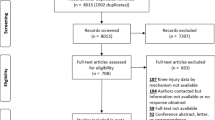Abstract
Purpose
The purpose of this study was to determine the difference in the concentrations of testosterone, 17-β estradiol and progesterone between female patients with and without ACL rupture and the possible effect of these hormones on generalised joint laxity.
Methods
Female subjects with non-contact knee joint injury were included in this study. They were divided into two groups: the examined group, consisting of female subjects with ACL rupture, and the control group, consisting of female patients without ACL rupture. In the next step, the patients from these two groups were paired off on the basis of three factors: the level of professional sports involvement (including the type of sports activity), the side of the body where the injury had occurred (left or right) and the age of the subjects. In the end, there were 12 pairs (24 subjects). The concentrations of sex hormones were established from saliva specimens with the aid of the Salimetrics enzyme immunoassay. Generalised joint laxity was tested with the aid of the “laxity score” according to Beighton, Solomon and Soskolne.
Results
Female subjects with ACL rupture had significantly lower concentrations of testosterone (p < 0.01), significantly lower concentrations of 17-β estradiol (p < 0.05) and significantly lower concentrations of progesterone (p < 0.01) than female subjects with intact ACL.
Conclusions
Decreased concentrations of testosterone, 17-β estradiol or progesterone may be a risk factor leading to ACL rupture. The concentrations of these hormones do not affect generalised joint laxity. Additional research on a larger group of patients is necessary to further determine the effects of these hormones on generalised joint laxity and ACL ruptures. Young female athletes with lower concentrations of sex hormones are more prone to anterior cruciate ligament rupture which is why they need to reduce their sports activities during the pre-ovulatory phase of the menstrual cycle, when these concentrations are additionally reduced.
Level of evidence
III.




Similar content being viewed by others
References
Arendt E, Agel J, Dick R (1999) Anterior cruciate ligament injury patterns among collegiate men and woman. J Athl Train 34:86–92
Arendt EA (2007) Musculoskeletal injuries of the knee: are females at greater risk? Minn Med 90:38–40
Asano K, Maruyama S, Usui T, Fujimoto N (2003) Regulation of estrogen receptor alpha and beta expression by testosteron in the rat prostate gland. Endocr J 50:281–287
Beighton PH, Solomon L, Soskolne CL (1973) Articular mobility in an African population. Ann Rheum Dis 32:413–418
Beynnon BD, Johnson RJ, Braun S, Sargent M, Bernstein IM, Skelly JM, Vacek PM (2006) The relationship between menstrual cycle phase and anterior cruciate ligament injury: a case control study of recreational alpine skiers. Am J Sports Med 34:757–764
Eiling E, Briant AL, Petersen W, Murphy A, Hohmann E (2007) Effect of menstrual-cycle hormone fluctuations on musculotendinous stiffness and knee joint laxity. Knee Surg Sports Traumatol Arthrosc 15:126–132
Gwinn D, Wilcknes J, McDewitt E, Ross G, Tzu-Vheg K (2000) The relative incidence of anterior cruciate ligament injury in man and woman at the United States Naval Academy. Am J Sports Med 28:98–102
Hamlet W, Liu S, Panossian V, Finerman G (1997) Primary immunolocalisation of androgen target cells in the human anterior cruciate ligament. J Orthop Res 15:657–663
Liu S, Al-Shaikh RA, Panossian V, Finerman GA, Lane J (1997) Estrogen affects the cellular metabolism of the anterior cruciate ligament. Am J Sports Med 25:704–709
Lovering RM, Romani WA (2005) Effect of testosterone on the female anterior cruciate ligament. Am J Physiol Regul Interg Comp Physiol 289:R15–R22
Nguyen AD, Shultz SJ (2007) Sex differences in lower extremity posture. J Orthop Sports Phys Ther 37:389–398
Pagnotta A, Specchia N, Greco F (2002) Androgen receptors in dupuytren`s contracture. J Orthop Res 20:163–168
Park SK, Stefanyshyn DJ, Loitz-Ramage B, Hart DA, Ronsky JL (2009) Changing hormone levels during the menstrual cycle affect knee laxity and stiffness in healthy female subjects. Am J Sports Med 37:588–598
Rasanen T, Messner K (2000) Estrogen dependent tensile properties of the rabbit knee medial collateral ligament. Scand J Med Sci Sports 10:20–27
Schultheiss OC, Dargel A, Rohde W (2003) Implicit motives and gonadal steroid hormones: effect of menstrual cycle phase, oral contraceptive use, and relationship status. Horm Behav 43:293–301
Shirtcliff EA, Granger DA, Likos A (2002) Gender differences in the validity of testosterone measured in saliva by immunoassay. Horm Behav 42:62–69
Slauterbeck J, Clevenger C, Lundberg W, Burchfield D (1999) Estrogen levels alters the failure load of the rabbit anterior cruciate ligament. J Orthop Res 17:405–408
Slauterbeck JR, Fuzie SF, Smith MP, Clark RJ, Xu K, Starch DW, Hardy DM (2002) The menstrual cycle, sex hormones, and anterior cruciate ligament injury. J Athl Train 37:275–278
Tipton C, Tcheng T, Mergner W (1971) Ligamentous strength measurements from hypophysectomized rats. Am J Physiol 221:1144–1150
Wentorf FA, Sudoh K, Moses C, Arendt EA, Carlson CS (2006) The effect of estrogen on material and mechanical properties of the intra- and extra-articular knee structures. Am J Sports Med 34:1948–1952
Wojtys EM, Huston L, Boynton MD, Spindler KP, Lindenfeld TN (2002) The effect of the menstrual cycle on anterior cruciate ligament in women as determined by hormone levels. Am J Sports Med 30:182–188
Yu WD, Liu S, Hatch JD, Panossian V, Finerman GA (1999) Effect of estrogen on cellular metabolism of the human anterior cruciate ligament. Clin Orthop Relat Res 366:229–238
Yu WD, Panossian V, Hatch JD, Liu S, Finerman GA (2001) Combined effect of estrogen and progesterone on anterior cruciate ligament. Clin Orthop Relat Res 383:268–281
Author information
Authors and Affiliations
Corresponding author
Rights and permissions
About this article
Cite this article
Stijak, L., Kadija, M., Djulejić, V. et al. The influence of sex hormones on anterior cruciate ligament rupture: female study. Knee Surg Sports Traumatol Arthrosc 23, 2742–2749 (2015). https://doi.org/10.1007/s00167-014-3077-3
Received:
Accepted:
Published:
Issue Date:
DOI: https://doi.org/10.1007/s00167-014-3077-3




